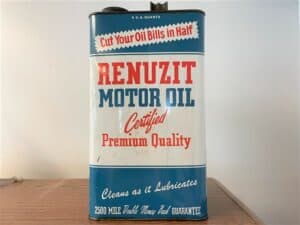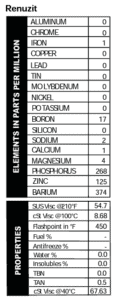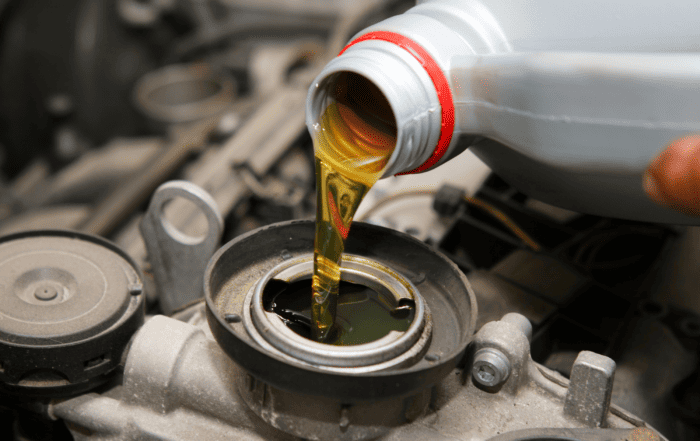The Renuzit Experiment
Is ZDDP really necessary?

A while back I wrote about buying close to 30 full cans of old oil on eBay, cracking them open, and testing them. It was fun to see what all these old oils looked like, and we ended up learning a lot, but at the end of it all, I had close to 30 Ball jars full of old oil that ended up sitting on the shelf here in the garage, and lingering questions about what to do with it all.
Among the stuff I bought was a gallon can of oil that I never heard of called Renuzit 20W/20. When it first arrived, I was slightly annoyed because the can itself had some rust on the bottom and was seeping oil. However, that turned out to be fortunate because it led me to try an experiment: Can I really run oil this old, and what would happen? 
I decided my 1984 Chevy pick-up truck would be a good test bed for this experiment. I have a lot of good base-line data on how it looks. It sees roughly the same type of use year-to-year, and best of all, if the engine exploded, I wouldn’t sue myself for damages.
So on a hot day in August 2012, with the help of my lovely assistant Natalie I actually dumped that stuff in. Was I nervous? You bet! Renuzit doesn’t exactly have a stout additive package, though that didn’t scare me too much. I’ve run oils in this engine that didn’t have any additive at all that we could read. 
The viscosity was a little light (in the 20W range), but that didn’t bother me too much either. This engine calls for a 10W/30, and anymore 10W/30 oil looks like 5W/30 after it’s used, and that’s just a few points higher than a 20W anyway.
I guess I was really nervous about destroying my engine. I have rebuilt it in the past, and I know I could do it again, but that doesn’t mean I want to. My wife wouldn’t be too happy about the time away from home and you never know, I might actually need my truck for transportation.
Still, after declaring my intentions to our good customers around the world, I couldn’t back down, so in it went. Upon first start-up I was relieved to see my oil pressure read normally. No funny smells came out of the engine/exhaust, and it seemed to run just fine. So far, so good. And with that, I proceeded to the next part of the test, which is always the hardest, putting miles on the engine.
Adding miles
My truck is basically a backup vehicle, used when I need to haul something or if one of our other vehicles is down, so getting miles on the oil isn’t really all that easy. I live about 1.7 miles from work, so if the weather is nice, I usually ride my bike. On top of that, my daily driver is a MINI convertible, which is about as fun of a car to drive as was ever made. Still, I worked hard and was able to get some miles on my truck.
Right off the bat, I noticed that the engine ran quieter than normal (of course, I also had some muffler work done at the same time, so that may have helped). By November, I was able to get about 400 miles on the engine, so I decided to test the oil (leaving it in use) and see how it was doing.
The test came back showing no trouble at all, so I was happy and started to feel better about this experiment. Winter is a slow time for the truck. It actually lives in my neighbor’s garage and doesn’t see a lot of use. Being a rear-wheel drive pick-up truck, it doesn’t do very well in the ice and snow. Eventually spring came so the truck use started to increase but that’s when tragedy struck!

Sad Mini
My MINI flooded one night while I was in Chicago with some friends. It was a rare occasion that the car actually spent time parked on the street in front of my friend’s house, and it just happened to be the night the north side of Fort Wayne got about six inches of rain in an hour. The street turned into a lake and my car went for a swim.
The bright side
The good news is that my truck was still running well and, being promoted to daily driver, I was going to start putting a lot of miles on it. Over the summer and into the fall I was able to accumulate almost 2,000 miles which is still short of 2,500-mile double-money back guarantee that the Renuzit can advertised, but a long run for my truck.
In fact, I was thinking about running the oil longer, but it was close to the “Add” mark on the dipstick, and not having any more of this oil, I decided to just go ahead and change it. A sample was taken (of course) and the results aren’t any better or worse that what I’ve received in the past.
So there you have it — an ancient oil run in a fairly modern engine, and no harm done. Would I run it again? Sure thing, except it goes against my principle of not paying any more than I have to for an oil change. That stuff was $75 for 5 quarts, plus $25 for shipping and that’s not in my budget, even if I could find it again. Still, this was a fun experiment, and since Blackstone still had a lot of old oil leftover from the eBay purchases, I decided to run those. Besides, it’s canning season and I need the jars.
Related articles
The Price We Pay to Soar
How does the Air Race Classic affect wear?
Landslide!
What size metals can we see? Think of a landslide
ZDDWhat?
An experiment to see if a lack of ZDDP will destroy an older, flat-tappet engine
To All the Oils I’ve Loved Before
What's the best kind of oil?








